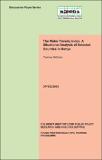Special Paper No. 09 of 2024 on Effect of Access to Clean and Safe, Adequate, Reliable and Affordable Water on Child Nutrition in Kenya
Publication Date
2024Author
Type
Otherviews
downloads
Metadata
Show full item recordBy
Isabella Kiplagat, Erick Macharia, Mary Karumba, Maurice Opondo, Roselyne Sitati, Dorcas Achieng’, Peter Kipkorir, Japheth Kathenge and Damaris Mulwa
Abstract/
Water security, which includes availability, physical accessibility, usage, and stability over time, is a crucial factor for improving nutrition. This paper goes beyond the dominant view of water access as mere ‘coverage’ to assess the relationship between the dimensions of water security and the nutritional status of children under five years old living in households with piped water in Kenya. Using data from the 2015/16 Kenya Integrated Household Budget Survey (KIHBS) and administrative records from the Water Services Regulatory Board (WASREB), a probit regression model was employed to estimate the effects of water accessibility, adequacy, quality, reliability, and affordability on child stunting. The findings of the study show that there is a rural-urban divide in water physical accessibility, quality, and adequacy. The study reveals that having sufficient drinking water at the household level significantly reduces child stunting. Adequacy of water of 20-49 litres per person per day as opposed to below 20 litres lowers the probability of stunting by 6.3 percentage points. Further, water reliability, affordability, access and quality have a potential to reduce stunting among children aged below five years. This evidence supports the importance of increased investment in water infrastructure to achieve universal access, improved water quality by implementing stringent monitoring and purification measures, strengthening the regulatory frameworks to ensure compliance and accountability, and expanded access to reliable water by developing efficient distribution systems, especially in rural areas where 65 per cent of people receive less than 20 litres of water a day. This strategic focus will not only improve child nutritional outcomes but also align with the country’s constitutional mandate to ensure the population has access to sufficient quantities of clean and safe water for drinking and personal use.
Publisher
National Information Platform on Food and Nutrition (NIPFN)Series
SP/09/2024;Collections
- NIPFN [24]
Related items
Showing items related by title, author, creator and subject.
-
Discussion Paper No. 133 of 2012 on The Water Poverty Index: A Situational Analysis of Selected Counties in Kenya.
Githiora, Yvonne (The Kenya Institute for Public Policy Research and Analysis (KIPPRA), 2012)Kenya is a water scarce country, and this impacts on the social and economic development goals. This study seeks to develop a Water Poverty Index to assess water resources at the county level. The Water Poverty Index ... -
Sessional Paper No. 01 of 1999 on The National Water Policy on Water Resources Management and Development
Ministry of Water Resources (Ministry of Water Resources, 1999)This Sessional Paper tackles issues pertaining to Water Resources Management, Water and Sewerage Development, Institutional Framework and Financing of the Sector. In each case an attempt has been made to discuss the problems ... -
Machakos County Water Policy 2018
County Government of Machakos (County Government of Machakos, 2018)The Machakos County Water Policy of June, 2014 has been developed in line with the vision of the Governor, Dr. Alfred Mutua, enshrined in his 2013 manifesto. In essence the Policy is built on the achievements of the sector ...




